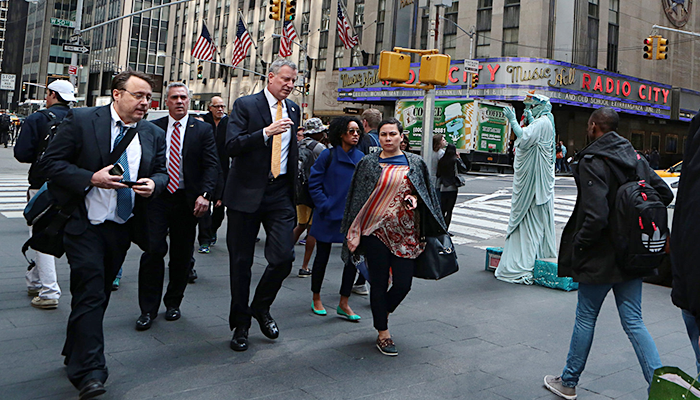
Housing Starts: 421-a Dilemma I Changes to Air Rights Afoot I End to Veteran Homelessness in NYC?

Mayor De Blasio in midtown (Photo Credit: Ed Reed/Office of Mayor Bill de Blasio)
- De Blasio’s 421-a Dilemma “There is always the risk that eliminating or significantly curtailing the 421-a property tax exemption would reduce the amount that developers of rental housing would be willing to pay for land,” Mark Willis, the executive director of New York University’s Furman Center, said in an email. “This possible decrease in land values might affect the new development pipeline in the short run. The city must carefully consider this possible impact, especially in light of the need for more housing affordable to middle- and lower-income New Yorkers.”
- DOB Overwhelmed by Construction Demand The Department of Buildings‘ review of new building plans has slowed to a crawl because the city agency is getting buried under an avalanche of permit applications. According to the most recent agency performance report from the Mayor’s Office of Operations, when it comes to new buildings it is taking the city’s DOB nearly twice as long to complete the first plan review, which is the period from the complete submission of the application to the date the plan examiner is able to issue a decision upon the submitted plans.
- Market-Rate Rents Gobble Incomes Renters can expect to spend nearly 60% of their incomes to afford a market-rate apartment in New York City, according to the study by StreetEasy, an online real-estate listing service. The report offers a glimpse into one aspect of the much-studied question of affordability in the city, looking at the median income of people who live here compared with the more than 140,000 listings that StreetEasy analyzed from its site.
- Rethink the City’s Affordability Problem (op-ed) To start, while affordability has reached a crisis level for many New Yorkers, ours is not a city in crisis. Quite the contrary: New York is thriving. To the extent that we have an affordability challenge, it is because our city is doing so well. We are attracting more residents and businesses than we can accommodate, which is driving up costs. As we properly focus on treating the negative symptoms of our generally positive condition, we need a robust plan to nurture the underlying condition itself.
- City May Alter Programs that Allow for Transfer of Air Rights The de Blasio administration is beginning a major evaluation of city programs that allow property owners to transfer their unused development rights, known colloquially as “air rights.” City planning commission chairman Carl Weisbrod said Thursday his department would undertake a “careful reconsideration our policy regarding T.D.R.s,” or transferable development rights, and noted “all ideas are on the table.” “We’re quite serious about this,” Weisbrod told attendees at a real estate conference held at Baruch College in Manhattan.
- Is the End in Sight for Veteran Homelessness in NYC? With its median home price at $135,000, the Pittsburgh metro had the lowest salary threshold on the list. According to the data, it would require a $31,716 salary to buy a home there. Unsurprisingly, San Francisco had the highest salary requirements: You’d need to pull in $142,448 to buy a home in that West Coast metro, where the median price is $742,900.
- What You Have to Earn to Afford a Home in 27 U.S. Metros New York is poised to become the largest U.S. city to end veteran homelessness by the end of 2015, an incredible achievement for a city that in 2012 had the second largest population of homeless veterans in the country. From 2011 to 2014, New York City achieved a 65 percent decrease in the number of veterans who experienced homelessness, from 4,677 to 1,645 – and by January 2015 saw a drop of another 50 percent to approximately 1,000. With the support of Mayor Bill de Blasio and the work of the New York City Continuum of Care (CoC) Veterans Task Force, the City is on track to solve what not long ago seemed to be an intractable problem.
- The Answer to New York City’s Housing Crisis: Smaller Apartments The city is betting on solutions like My Micro NY, a pioneering new project that’s currently in construction, with prefabricated units smaller than most existing studio apartments. The units are being constructed locally, and will eventually be assembled in downtown Manhattan. The apartments will be for one to two people and range in size from 250 to 350 square feet. New York isn’t exactly known for huge apartments, but these units are so small that the project received a one-time exemption from city zoning codes to make the building possible.
- Charles Barron’s Associates Lead Push to Slow Down East New York Rezoning Two community leaders with close ties to Assemblyman Charles Barron have placed a roadblock in front of Mayor Bill de Blasio’s grand vision to bring thousands of affordable housing units to East New York. Longtime Barron associates Andre Mitchell and Viola Plummer led a successful vote last week by East New York’s local community board to suspend all presentations by developers and city agencies to its members in hopes of slowing down a rezoning process that is expected to dramatically transform the neighborhood.
- North America’s Radiant City: Le Corbusier’s Impact on New York Stuyvesant Town and Peter Cooper Village (commonly referred to as “Stuy Town”) was an early example of a towers-in-the-park design in New York. In 1942, under the development of the Metropolitan Life Insurance Company, planning began on a post-war housing project designed to give veterans priority in affordable housing selection. The design, meant to create the feeling of country within a city, was conceived by the “master planner” Robert Moses. Construction began on the $50 million complex in 1945, replacing the 18 city blocks that once housed the Gas House District.


